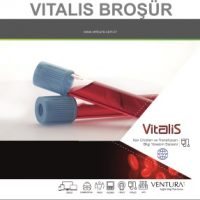Destek Talebi Açmak İçin Tıklayınız.
VITALIS: A System for Managing Blood Products and Transfusion Information
VITALIS is Turkey’s first and only Blood Bank Information System that can be integrated with LIS and HIS. It is designed to be flexible enough to meet Blood Banks’ recording, reporting, and storage requirements. VITALIS can operate either integrated or independently with the ALIS Laboratory Information System.
Functional Features
- Donation Acceptance Form: The Blood Bank’s donation acceptance form can be created in VITALIS, allowing default answers pre-entered. The system can record the donor’s responses to the questions in the form and provide statistical reports when needed.
- Donor Information: During donors’ acceptance or rejection phase, assistance can be provided regarding their medical conditions or medications.
- Permanent/Temporary Rejection: The system allows for the recording of demographic information of the donor or patient. Based on the answers provided by the donor in the acceptance form and physical examination findings, the system can either accept or reject the donor temporarily or permanently. Additionally, the physical examination results can also be recorded in the system.
- Documentation of Test Results: Ability to record test results (e.g., blood group) before drawing blood into the blood bag or starting apheresis and storing them in the system.
- Blood Collection Details: Blood collection information, including collection time, blood type, product volume, and type (FFP, Whole Blood), can be recorded in the system.
- Blood Products from Other Centers: If the blood product is received from another center, the blood center and product information can be stored in the system.
- Cabinet and Location Information of Stored Blood Bags: The system enables registration of blood bags and identification of the cabinet where they are stored. Barcodes, with or without the ISBT standard, can be printed for individual blood bags, or pre-printed barcodes can be used as required.
- Forward, Reverse, and RH Subgroups: Authorized users can define forward, reverse, and RH subgroups to the blood bank system.
- Blood Group Separation: The blood product can be divided into sub-groups and administered to patients based on main or sub-group blood types.
- All operations are being recorded: The system can record product operations such as irradiation and washing, along with date, time, and technician information.
- Processing of Tests – Manual vs Automatic: Tests performed on blood products can be recorded manually or automatically from the analyzer. Results can be approved at different levels.
- Monitoring Tests: Before or after placing the blood product in the bag, which tests are performed, and all details about these tests can be arranged according to the blood center’s working system.
- Unfit blood cannot be released for any use except for destruction: Blood that has produced unsuitable test results can only be removed from the stock to be destroyed.
- Blood Bag Separation: The blood bags can be divided into separate products or reduced in quantity. In such cases, new products can be recorded in the inventory along with their location information, while the old product can only be removed from the inventory for destruction purposes.
- Reservation of Blood Bags: The blood bags can be reserved for another patient, and their reservation history can be tracked.
- Cross-Match Records: Detailed information about cross-matching blood products for other patients can be recorded in the system.
- Antibody Screening and Identification: Blood products can be searched by antibody name after recording antibody screening and identification.
- Expiration Tracking: Blood bag expiration dates can be tracked by product type. Lists of soon-to-expire bags can be obtained, and disposal information for expired products can be entered into the system.
- Monitoring Blood Requests with Time/Date: If a blood request is required for the patient, the system allows for the entry of the date and time of the request using a barcode reader or manual input based on the blood bank’s procedures, any unused blood must be either accepted or rejected within a specific time frame. Related product movements can be tracked for record-keeping purposes.
- Stock – Inventory Management: The blood can be removed from the cabinet autologously or according to FIFO.
- Apheresis and Therapeutic Apheresis Procedures: The system can record and track donor apheresis and therapeutic apheresis processes. Additionally, any other blood products obtained during apheresis can be entered into the blood bank inventory.
- Identifying the Critical Stock Level: It is possible to determine and report a critical stock level for the blood bank inventory, which can be compared to the amount of material in stock. The user can receive a warning if the necessary stock level falls below the threshold for blood discharge.
- Integration with Other Blood Centers: In case of integration with other blood centers, the stock level of other blood centers above the critical level can be seen, or only the bag products that the blood bank can determine can be seen.
- Transfusion Report: If the product is ready for the patient, a transfusion report can be generated, including the information to be filled in by the nurse or doctor later. In case of any adverse reaction from the patient, the system will alert the user during the next blood draw for that patient.
- Donor Information Letter: A donor can receive an information letter about their past blood donations.
- Patient Relative – Blood Request Form: If blood is unavailable at the blood center, a blood request form can be provided for the patient’s relative.
- Patient Relative – Automatic Reservation: If a patient’s relative donates blood, the blood product can be recorded in the blood center’s stock and automatically reserved for the patient. The relative can receive a document stating that blood products are reserved for their relative.
- Report on Test Results: All test results performed on the donor or the patient can be printed and given.
- EIA Positive: A list can be created to notify patients or donors with positive EIA test results, which can then be recorded in the system.
- Donor Call List: The FFS products can be removed from stock through the quarantine system. Moreover, a list can be generated of donors who have agreed to be called back for blood donation when needed. The system can also save call records of the donors who have been contacted.
- Donor Tracking: The citizenship identification number can be used in donor identification information for donor tracking. Identification information can be obtained automatically from the General Directorate of Population and Citizenship website.
- Official Reports: Statistics or reports that may be requested by institutions such as the Ministry of Health or accreditation bodies can be obtained from the system automatically.
- Stock Tracking with Barcode: Barcodes can be used to manage and monitor stocks efficiently.
- Detailed Statistics: All types of necessary statistics regarding the transactions conducted by the Blood Bank can be obtained.



